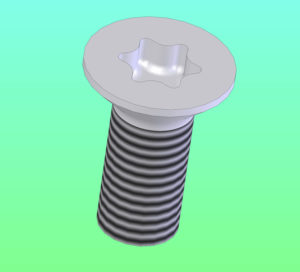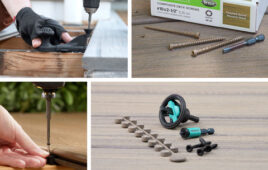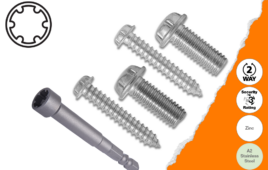Written by Jody Muelaner

A Torx screw is a fastener with a six-lobed star drive socket or, less commonly, an external head.
A Torx screw is a type of screw characterized by its six lobed-star patterned screw drives. Torx drive is a trademark commonly referred to as a star drive or six-lobe, abbreviated to TX or 6lobe. The ISO name is hexalobular.
Torx is available as an internal and external drive although it is most commonly used as a socket within the head (internal).
These fasteners were invented in 1967, by Camcar Textron, as an improvement on contemporary drive types. Specifically, the screws were designed to replace Phillips that had an internal hex drive, which was prone to fail at high torque by rounding off and cam-out.
Torx does not cam-out and can withstand higher torques than internal hex at a given head size. Vertical sidewalls maximize tool engagement and produce no cam-out forces to push the driver out of the screw head, resulting in less fatigue as no end load is required. There’s also less likelihood of damaging the driver or driven screw.
With a drive angle that’s perpendicular to the axis of the fastener, Torx drive produces little radial force. This allows for a higher torque to be transmitted with little likelihood of reaming or other failures, including with the driver or the driven screw.
Torx internal drive screws are often used within the automotive, IT, and consumer electronics manufacturing sectors. They’re also increasingly used in other industries, such as construction.
The internal head sizes are demarked by a capital letter ‘T,’ followed by numbers 1 to 100, with smaller ones representing smaller head sizes. Common sizes are T10, T15, and T25, with inch and metric sized fasteners sharing the same sized drive tools.
External-drive Torx is demarked by a capital letter “E,” followed by numbers 4 to 40, with the ones that do not correspond to the internal Torx. External drive Torx is less common, however, it has gained some popularity in machine screws and lag screws as an alternative drive head type to hex.
Successors to Torx include the Torx Plus, which was introduced in the early ’90s. Its squarer lobes promised to increase drive bit life. In 2017, the latest Torx successor, Torx Paralobe, was released, offering 20% greater torsional strength and 20% greater drive life than Torx Plus.
Early uses of Torx included as a security screw head because it was an uncommon driver type. But as it gained popularity other drives were invented to fill this role.
One design features, “center pin reject,” known as Security Torx, Tamper-Resistant Torx, or pin-in Torx, and abbreviated as TR. It has a solid post in the center of the screw socket that prevents a standard driver from entering and requires a specialist hollow-headed driver.
Another security screw design inspired by Torx is a five-lobed star pattern, known as the Pentalobe Security Screw, which has been featured on Apple products since 2009. Torx ttap, is a spin-off product promising a magnet-free solution to stabilizing the screw on the driver through the use of a second recess in the head matching a pin on the driver.





Tell Us What You Think!